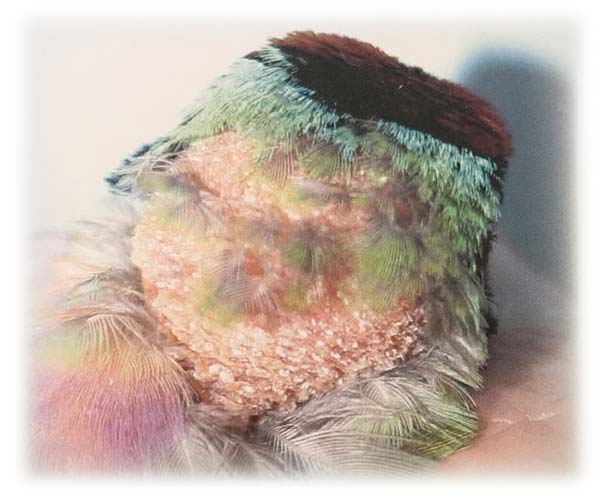Baldness in Gouldian Finches
Gouldians hold a special position amongst the finch family of birds as they are capable of accelerating the moult (compressed moult) or slowing the moult (delayed moult) in response to adverse environmental conditions.
In wild Gouldians, a compressed wing moult occurs under ideal climatic conditions when food supplies are plentiful allowing multiple flight feathers to grow simultaneously. A delayed moult occurs when food supply is poor.
In captive birds, a compressed wing moult is a sign of good health and a well balanced diet. 
A delayed moult is often not recognised until baldness appears towards the end of the moult.
Baldness is a common finding in captive birds that often occurs towards the end of the moult period.
The normal moult period for Gouldians is between January-June 1st in the Northern Hemisphere and June to December 1st in the Southern Hemisphere.
When baldness appears during the normal moult period i.e. during November/December in Southern Hemisphere or during May/June in Northern Hemisphere,
This indicates that the progress of the moult has been slowed due to some stressful factor
Possible Causes of Baldness – Associated with a Delayed Moult
-
Poor nutrition – especially protein, iodine, calcium and vitamin D deficiencies.
-
Climatic changes – cold spells, fluctuating temperature and humidity, excessively high humidity or inadequate sunlight (i.e. poor UV spectrum).
-
Disease – especially airsac mite infection.
-
Prolonged breeding activities.
A delayed moult usually ends up with baldness when poor nutrition and sudden climatic changes lower immunity and trigger an airsac mite infection.
Without looking at the stage of the wing moult it is difficult to recognise a delayed moult until the end of the moult period.
When baldness appears towards the end of the moult cycle, underlying causes are narrowed to inadequate diet or an underlying Airsac mite infection.
Baldness that appears outside the normal moult period may indicate other conditions such as fungal, yeast or bacterial infections.
Treatment of Baldness
The immediate treatment of baldness should focus on correcting a deficient diet and administering S76/moxidectin to treat airsac mite infection.
Add nutritional supplements to diet – Please see Dr Rob Marshall`s Bird Moult Health Program.
S76 treatment for 2 days each week for 3 weeks. Follow up treatments are required as part of airsac mite prevention.
Prevention of Baldness
In the past, Iodine has been used to treat balding in Gouldians because liquid Iodine stimulates the thyroid gland and induces a moult.
Iodine is a very necessary part of the treatment of baldness but when used alone, does not provide the correct nutritional balance to support a rapid moult.
It should be incorporated with a complete nutritional programme that provides both energy and nutrients to moulting birds.
Breeding & Baldness
Birds exhibiting baldness will not have the energy or nutrient supplies to sustain breeding and will invariably fail at some time during the breeding season.
These birds should not be bred during the breeding season immediately following the moult.
However baldness is not necessarily a sign of a weak bird but more a sign of poor nutrition and other stressful factors.
Birds that moult successfully the season following baldness should go on to breed well the next breeding season.
If baldness occurs again the following season, a genetic weakness is present and these birds should not be used for breeding.
This genetic weakness is often related to inbreeding.

Has this been useful?
If this help has been useful please consider donating so we can provide more help in the future
![]()
